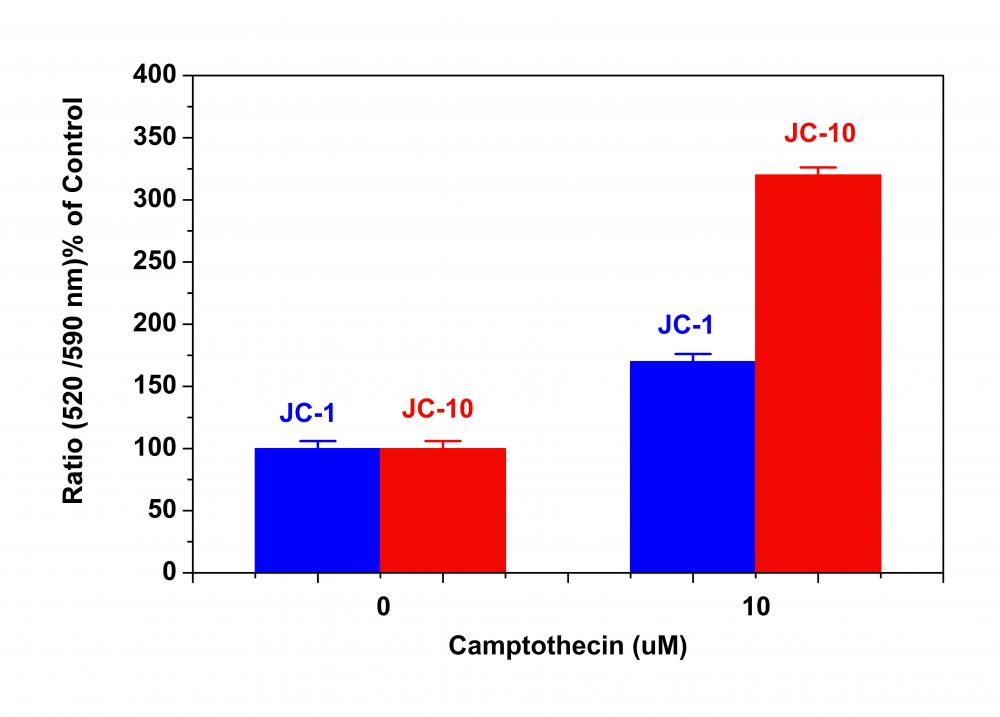上海金畔生物科技有限公司代理AAT Bioquest荧光染料全线产品,欢迎访问AAT Bioquest荧光染料官网了解更多信息。
线粒体膜电位荧光探针JC-1 CAS 3520-43-2价格 1386
产品规格
产品货号
| Ex (nm) | 515 | Em (nm) | 530 |
| 分子量 | 652.23 | 溶剂 | DMSO |
| 存储条件 | 在零下15度以下保存, 避免光照 |
线粒体膜电位荧光探针JC-1是美国AAT Bioquest生产的用于线粒体膜电位检测的试剂,JC-1广泛用于通过流式细胞术确定线粒体膜电位。它能够选择性地进入线粒体,并且随着线粒体膜电位增加(超过约80-100mV的值)可逆地将其颜色从绿色变为橙色。这种性质是由于线粒体膜极化后JC-1聚集体的可逆形式导致发射光从530nm(即JC-1单体形式的发射)转变为590nm(即J-聚集形式的发射)。当在490nm处激发时,随着线粒体膜变得更加极化,JC-1的颜色从绿色橙色可逆地变为绿色橙色。使用通常安装在所有流式细胞仪中的滤波器可以检测两种颜色,可以在荧光通道1(FL1)中分析绿色发射,在通道2(FL2)中分析绿色橙色发射。使用JC-1的主要优点是,它可以从绿色到橙色荧光发射转移,它既可以定性,又可以在FL1和FL2通道中检测到纯荧光强度又可以定量。除了广泛用于流式细胞仪外,JC-1还用于荧光成像。我们已经开发出一种在荧光酶标仪平台中使用它的方案,尽管JC-1在许多实验室中被广泛使用,但其水溶性差使得它在某些应用中难以使用。我们的JC-10具有比JC-1更好的水溶性,并且JC-10在一些细胞系中具有优于JC-1的性能。金畔生物是AAT Bioquest 的中国代理商,为您提供优质的线粒体膜电位荧光探针。
点击查看光谱
适用仪器
| 流式细胞仪 | |
| Ex: | 488 nm |
| Em: | 530/30 nm, 575/26 nm |
| 通道: | FITC, PE通道 |
|
荧光显微镜 |
|
| Ex: | 490 nm |
| Em: | 525 nm(比率分析为 590 nm) |
| 推荐孔板: | 黑色透明底板 |
| 通道: | FITC 和 TRITC通道 |
|
荧光酶标仪 |
|
| Ex: | 490 nm |
| Em: | 525 nm(比率分析为 590 nm) |
| 推荐孔板: | 纯黑色孔板 |
JC-1样品分析方案
概述
用测试化合物制备细胞
添加JC-1工作溶液(100μL/孔用于96孔板或25μL/孔用于384孔板)在室温或37℃孵育1小时
移除JC-1工作溶液
读取 Ex / Em = 490 / 525nm和490 / 590nm处的荧光强度
注意:以下是我们推荐的活细胞方案。该方案仅提供指南,实际情况应根据您的具体实验进行调整修改。
1.准备JC-1工作溶液:
1.1在高质量无水DMSO中制备2至10 mM JC-1的储备液。 应随用随配及时使用或等分配制,应将使用剩余的溶液等分并在<-20℃冷冻。
注意:避免反复冻融循环,避免光照。
1.2制备1X JC-1工作溶液:在实验当天,将JC-1固体溶解在DMSO中或将等分试样的JC-1储备溶液解冻至室温。在Hanks和20 mM Hepes缓冲液(HHBS)或其他缓冲液(pH 7)和0.02%Pluronic®F-127中制备10至30μM1XJC-1工作溶液。
注意:JC-1不溶于水,因此它会在溶液中聚集。 建议在将JC-1工作溶液加载到微孔板之前对其进行过滤。
2.用荧光酶标仪进行JC-1检测:
2.1用测试化合物细胞培养所需的一段时间(例如,Jurkat细胞可以用喜树碱处理4-6小时)以诱导细胞凋亡。对于空白孔(没有细胞的培养基),加入相应量的化合物缓冲液。
2.2将100μL/孔的96孔板或25μL/孔的384孔板的JC-1工作溶液(来自步骤1.2)加入到细胞板中。
2.3将JC-1加载在37℃,5%CO2培养箱中培养15-60分钟。
注意:适当的孵育时间取决于所使用的单个细胞类型和细胞浓度,每个实验的孵育时间需要根据相应实验进行控制。
2.4从平板上取下JC-1工作溶液,用HHBS或其他缓冲液清洗细胞。 将100μL/孔的96孔板或25μL/孔的384孔HHBS板加回到细胞板中。
2.5监测Ex / Em = 490 / 525nm和490 / 590nm处的荧光变化以进行比率分析。
3.用荧光显微镜或流式细胞仪进行JC-1测定:
3.1用测试化合物细胞培养所需的一段时间(例如,Jurkat细胞可以用喜树碱处理4-6小时)以诱导细胞凋亡。
3.2离心细胞,每管取1-5×105个细胞。
3.3在500μLJC-1工作溶液中重悬细胞(来自步骤1.2)。
3.4在室温或37°C下避光孵育10至30分钟。
3.5用HHBS或其他缓冲液洗涤细胞。将细胞重悬于500μLHHBS中以获得每管1-5×105个细胞。
3.6用荧光显微镜(使用FITC和TRITC滤光片)或流式细胞仪(使用FL1和FL2通道)观察Ex / Em = 490 / 525nm和490 / 590nm处的荧光变化。
参考文献
Cell death mechanisms of the anti-cancer drug etoposide on human cardiomyocytes isolated from pluripotent stem cells
Authors: Harshal Nemade, Umesh Chaudhari, Aviseka Acharya, Jürgen Hescheler, Jan Georg Hengstler, Symeon Papadopoulos, Agapios Sachinidis
Journal: Archives of Toxicology (2018): 1–18
Mesenchymal stem cells ameliorate hyperglycemia-induced endothelial injury through modulation of mitophagy
Authors: Wuzheng Zhu, Yujia Yuan, Guangneng Liao, Lan Li, Jingping Liu, Younan Chen, Jie Zhang, Jingqiu Cheng, Yanrong Lu
Journal: Cell Death & Disease (2018): 837
overexpression of protocadherin 7 inhibits neuronal survival by downregulating Birc5 in vitro
Authors: Huajuan Xiao, Ziling Sun, Jun Wan, Shengtao Hou, Yi Xiong
Journal: Experimental cell research (2018): 71–80
Therapeutic potential of GSK-J4, a histone demethylase KDM6B/JMJD3 inhibitor, for acute myeloid leukemia
Authors: Yunan Li, Mingying Zhang, Mengyao Sheng, Peng Zhang, Zizhen Chen, Wen Xing, Jie Bai, Tao Cheng, Feng-Chun Yang, Yuan Zhou
Journal: Journal of Cancer Research and Clinical Oncology (2018): 1–13
Hyaluronan polymeric micelles for topical drug delivery
Authors: Daniela Smejkalová, Tomáš Muthny, Kristina Nešporová, Martina Hermannová, Eva Achbergerová, Gloria Huerta-Angeles, Marek Svoboda, Martin Cepa, Veronika Machalová, Dominika Luptáková
Journal: Carbohydrate Polymers (2017): 86–96
New ruthenium compounds bearing semicarbazone 2-formylopyridine moiety: Playing with auxiliary ligands for tuning the mechanism of biological activity
Authors: Michal Lomzik, Olga Mazuryk, Dorota Rutkowska-Zbik, Grazyna Stochel, Philippe C Gros, Malgorzata Brindell
Journal: Journal of Inorganic Biochemistry (2017)
Inhibition of mTOR’s Catalytic Site by PKI-587 Is a Promising Therapeutic Option for Gastroenteropancreatic Neuroendocrine Tumor Disease
Authors: Helma Freitag, Friederike Christen, Florentine Lewens, Irina Grass, Franziska Briest, Sara Iwaszkiewicz, Britta Siegmund, Patricia Grabowski
Journal: Neuroendocrinology (2016)
Mesenchymal Stem Cells-Conditioned Media Ameliorates Diabetic Endothelial dysfunction by Improving Mitochondrial Bioenergetics via the Sirt1/AMPK/PGC-1α Pathway
Authors: Yujia Yuan, Meimei Shi, Lan Li, Jingping Liu, Bo Chen, Younan Chen, Xingxing An, Shuyun Liu, Ruixi Luo, Dan Long
Journal: Clinical Science (2016): CS20160235
mTOR complex-2 stimulates acetyl-CoA and de novo lipogenesis through ATP citrate lyase in HER2/PIK3CA-hyperactive breast cancer
Authors: Yaqing Chen, Jianchang Qian, Qun He, Hui Zhao, Lourdes Toral-Barza, Celine Shi, Xuesai Zhang, Jiang Wu, Ker Yu
Journal: Oncotarget (2016): 25224–25240
Multiple Active Compounds from Viscum album L. Synergistically Converge to Promote Apoptosis in Ewing Sarcoma
Authors: Monika Twardziok, Susann Kleinsimon, Jana Rolff, Sebastian Jäger, Angelika Eggert, Georg Seifert, Catharina I Delebinski
Journal: PloS one (2016): e0159749

